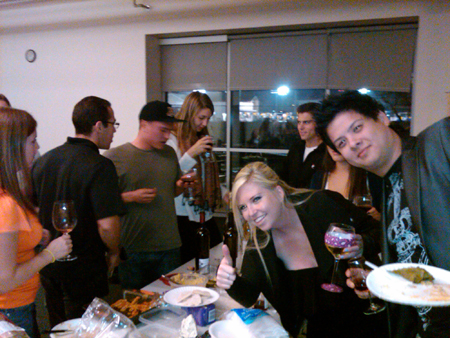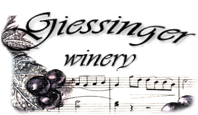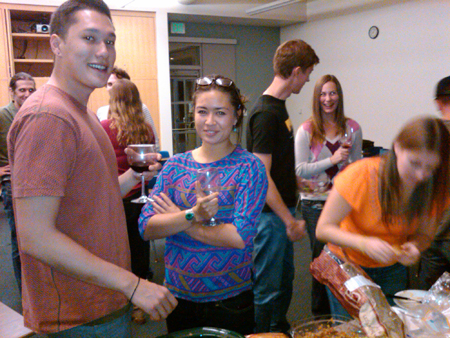WESTLAKE WINE Class
coming soon
Explore the world of winemaking with today’s deal from Giessinger Winery. You will spend 60 minutes with Dr. Giessinger, tasting and learning about wine and how to make it. This in-demand class, offered regularly at UCSB, now comes to Westlake Village.
- Held at 7:00 p.m. on Fridays in Westlake Village
- Learn how to make 5 gallons of wine in a nice, social environment
- Includes: tasting of 2 whites, 1 rosé, 2 reds, 2 dessert wines, and 1 port
- Take-home 1 bottle of premium chardonnay
- The curriculum will touch on the process of winemaking (growing and purchasing of grapes, choosing equipment, fermenting, bottling, and storing) as well as on the health benefits of wines
- Savor the wild yeast fermented Petite Sirah or Cabernet Sauvignon.
- Awarded “Best wines in Santa Barbara” in 2021 by the U.S. Commerce Association


- Instructor
- Dr. Edouard Giessinger
- Bring to first class
- Pen, paper, bread or simple food, and your enrollment receipt. We provide the glasses.
- Class fee
- $200
- Note
- You must be at least 21 years of age to enroll in this class. You have to enroll in person for age verification.
Facts
Fermentation/microbiological phase:
Grapes + yeast Enzymes ———-> Alcohol + CO2 + ATP (heat)
Dry wines: are the result of an unstopped finished fermentation
Fruity wines: are the result of a stopped unfinished fermentation.
This process is challenging since it requires to find the right balance before stopping the fermentation.
Notes:
1. Cork: some of our wines contain some cork ships. It’s alright. In fact, cork is a good absorbent of some of the newly formed substances during bottle aging.
2. Sediments: some of our wines contain some grape sediments. It’s alright. They add character to the wine.
3. Port: once in a while some our Port bottles leak. It’s alright. It’s due to wine expansion because of high alcohol content and temperature variation. In fact, matured Ports in wooden barrels, whose permeability allows a small amount of oxygen exposure, experience what is known as oxidative aging.
Fermentation/microbiological phase:
Wine tasting is an experience. Here at Giessinger winery we try to experiment with all kind of wine making styles to accommodate your palate. Whether the wine is dry, fruity, or sweet it is your palate that matters at the end. Your appreciation and choice of wine is dictated by your palate and not by what others like or say. Always remember, the best wine is the one you like.
Understanding How To Taste Wine
By Claire Holt
So you like to drink wine. You know what you like and what doesn’t agree with you. Do you really know how to taste it though? Wine tasting isn’t as complicated as it is sometimes made out to be and knowing how to taste properly can greatly enhance your appreciation and enjoyment.
Writing a tasting note
Writing your own tasting notes is a good way to build up your wine-tasting skills. Your description of a wine can serve as a personal reminder, as unless it is genuinely unforgettable you will soon forget its characteristics and most probably its vintage and name. A tasting note will also help you describe a wine to somebody else and building up a library of tasting notes will help you discern a pattern about the types of wine you like or dislike.
When you taste a wine you use three of your senses: sight, smell and taste. Your tasting note should have sections for each of these under the headings of Appearance, Nose and Palate. You can also leave space your conclusions at the end.
Appearance
Your first check should be to see whether a wine is clear and bright. You are best trying to do this against a white background. Any cloudiness or dullness in the wine might suggest that it is faulty. Next, note the depth and color of the wine. Frascati for example is almost see-through white, while Pinot Noir is the palest of the red wine varieties. Reds such as those made with Shiraz or Cabernet Sauvignon grapes have a much deeper, almost opaque appearance.
Try and describe the color in detail using adjectives such as straw, lemon or gold for white wines and purple, ruby, pink and tawny for reds. As well as the color at the center of the glass, look for the color on the rim when you tip the glass. Young red wines for example will be purple or pink on the rim while older wines display more orange and brown. If you are tasting a sparkling wine comment on the appearance of the fizz or the size of the bubbles.
Nose
You will pick up some type of scent from a wine simply by holding up a glass to your nose but the experience will be enhanced by swirling the wine round the glass first. Check first that the wine isn’t corked or faulty – it will smell mouldy or of damp grass if this is the case. Assuming that the wine smells clean and fresh, try and describe the intensity of the smell in your notes and the type of aroma you sense. Is the wine fruit or floral? Earthy or spicy? If you feel confident try and see if there are any further aromas that you pick up. Wine critics come in for some stick about the descriptions they give to wine but some are known to have a scientific basis. The gooseberry aroma often associated with Sauvignon Blanc for example seems to be caused by compounds called methoxpryzaines.
Palate
Tasting the wine is obviously the part that the majority of us look forward to most. The first thing to sense is whether the wine is sweet, medium or dry. Then try and get a feel for the acidity of the wine – you can taste acidity on the side of your tongue. The next thing is to gauge is the alcohol content of the wine. You will pick this up not so much through the taste but by how much of a warmth a wine leaves in your mouth. The average wine is around 12.5% ABV and this will leave just a gentle warmness in your mouth. Stronger wines going up to 13.5% or even beyond will have more of a hot peppery burn to them. It’s important not to get carried away when tasting wines. Swallowing a number of different wines in quick succession will involve intake of unhealthy levels of alcohol over a short period and will also diminish your ability to properly appreciate the wines you are tasting. The final thing to test on the palate is the strength of the tannins in the wine. Found in red wines, these are naturally occurring compounds extracted from the black grape skins along with the red color. A wine with strong tannins will leave you with a sandy, gum-drying sensation.
Conclusions
The conclusions of your wine tasting notes should draw all of your experiences together. Focus on the finish of the wine, i.e. how long the taste remains in your mouth and also try to evaluate the quality against the price of the wine. Once you have mastered the basics of tasting you may be ready to move onto the more complex task of matching food with wine….
Messages In Bottles
By Claire Holt
The festive pop of a champagne cork, the chinking of newly-filled glasses in a toast, many of life’s celebrations involve a glass of wine. Those with some knowledge of wines will aim to pick the perfect wine for each occasion and serve it in the appropriate glass. Those who are interested in learning more about wine and its history should, however, take a good look at the bottle, because its development was largely responsible for the fact that people today can now simply pop into a store to pick up their favorite wine.
A Brief History Of Storing Wine
Wine has been around a lot longer than the glass bottles which commonly hold it today. It’s unclear when wine production began but it was certainly well established by 4000BC. Glass was only invented around 3000BC but initially was a luxury item meaning that it was too expensive as well as too fragile to be used for storing wine, although there is evidence that glass decanters were used at formal events. By Roman times the practice of storing wines in clay containers was widespread and the Romans developed amphorae for easy storage and transportation. Wooden barrels were another popular choice and were more robust than clay. The invention of the furnace in the 17th Century was a huge step forward for the wine industry. It allowed for the production of much stronger glass, which meant selling wine in bottles became a realistic prospect. This allowed for much greater flexibility in storage and transportation. Travelers in particular can thank the inventor of the glass bottle for the fact that they can enjoy a selection of wines on ships and later trains and planes, where storing a selection of clay containers or barrels would simply have been impractical. Today’s cruise ships have become famous for their gourmet cuisine as much as for the opportunity to experience a unique way of travel and for many people achieving the right pairing of food and wine is a crucial part of any high-quality meal. Indeed in some cruises food and drink is the focus of the trip, as people look to expand their culinary knowledge by visiting specialist producers.
Why Is Glass So Good?
Glass is a great way of storing wine. It’s relatively strong and provides good protection against the elements. Colored glass also gives protection against light, which is very bad for wine. This is why traditionally wine bottles were made out of darker glass whereas wine glasses were made out of clear glass so that drinkers could appreciate the color of the wine before they drank it. Glass also offers much more flexibility in terms of creating individual designs and this became increasingly important in the 18th Century as people began to become more aware of the individuality of wines and the importance of recognizing individual producers. Just as modern companies pay great attention to the packaging they use and to the message it sends out, so their 18th Century counterparts thought about the design of the bottles and creating the right blend of practicality, beauty and individuality. It was for practical reasons that the original, short, circular bottles gave way to the cylindrical bottles largely used today. Good wine is best stored on its side and cylindrical bottles were more space-efficient for this purpose. It was also the reason why winemakers agreed to adopt a standardized size for bottles, although this only happened in the late 20th Century. The reason for this was that even after the invention of the furnace, bottles were still blown by hand and their size essentially depended on how much air the glassblower had in their lungs. This usually meant somewhere between 700 and 800ml. When factory production began, each individual wine-maker ordered their own size of bottle which was usually around this size. As the possibilities for international trade in wine increased, so it became increasingly obvious that it would be useful to have a standard size of bottle and in 1979 the U.S. chose the 750ml size. Other countries simply accepted this, partly for ease of trade with the U.S.
The Right Bottle For The Job
While there was agreement about a standard size, winemakers were still perfectly free to use whatever shape they wished and modern wine bottles are now a combination of art and science. Sparkling wines, for example, tend to be sold in thicker bottles than still wines due to the pressure of the carbonation. Bottles for Bordeaux wines by contrast are designed to trap sediment before it reaches a drinker’s glass. At the same time bottles are still used to identify a particular style of wine or manufacturer, making it easy for time-pressed shoppers to find what they want quickly.




